22 Fire-Resistant Plants for Home Gardeners
Protect your home and yard from wildfires by using fire-retardant plants
With a changing climate, mean global temperatures are rising, resulting in more prolonged periods of heat and drought. This has led to an increase in wildfires. According to The Washington Post, 1 in 6 Americans, particularly those in California, live in areas “with significant wildfire risk,” and those numbers are increasing. Those who live in fire-prone areas, such as near woodlands or open rangeland, are the most vulnerable.
The type of vegetation in the landscape can affect the risk of fire damage to homes and properties. Some plants are more flammable than others, providing fuel that can make a fire worse. “Fire-resistant” doesn’t mean that plants are fireproof.
Homeowners can help protect their properties by including fire-resistant plants in their landscape. Here are some of the best fire-resistant plants to add to your yard.
 1. Beardtongue‘Midnight Masquerade’ Zones: 3-8 Also known as penstemon, this tough, prairie-native perennial produces tubular flowers that attract hummingbirds and beneficial insect pollinators. ‘Midnight Masquerade’ has pale-lavender flowers that contrast with deep-burgundy foliage for multi-seasonal appeal. Plants are adapted to drought conditions and conserve moisture in their foliage, making them more resistant to igniting. |
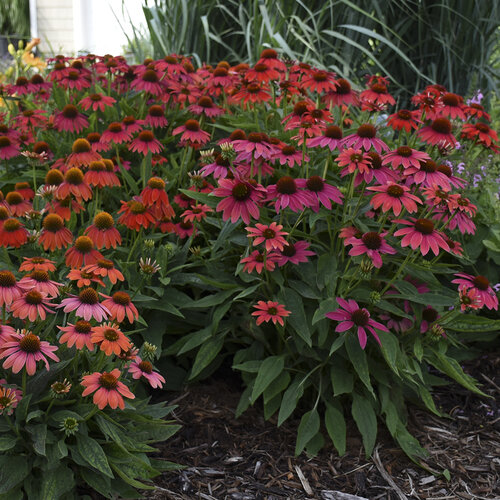 2. ConeflowerSummersong™ Firefinch™ Zones: 4-8 This North American native plant is revered by gardeners for its attractive cone-shaped flowers, which support a range of wildlife. A colorful hybrid, Summersong™ Firefinch™ has flowers in variable shades of red, orange-red, and pink, with a petite stature suitable for smaller yards. Coneflower is often included on fire-resistant plant lists for its drought tolerance, flame-resistant properties, and ability to recover quickly from wildfires. |
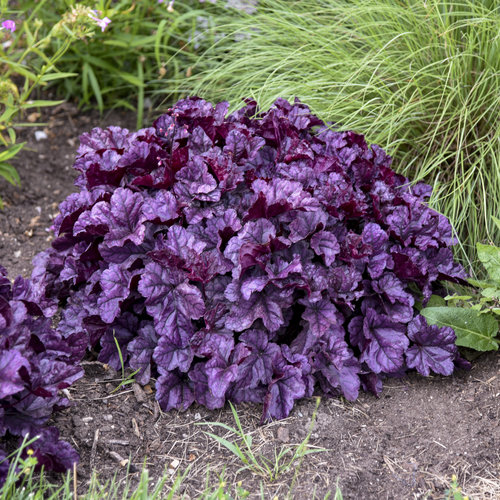 3. Coral BellsDolce® ‘Wildberry’ Zones: 4-9 Grown for the decorative foliage, this hardy perennial thrives in a wide range of growing conditions and is suitable for shade borders and rock gardens. Dolce® ‘Wildberry’ produces vibrant, purple foliage with a scalloped edge. The compact habit makes coral bells less flammable, making it a good choice to plant near homes or other structures. |
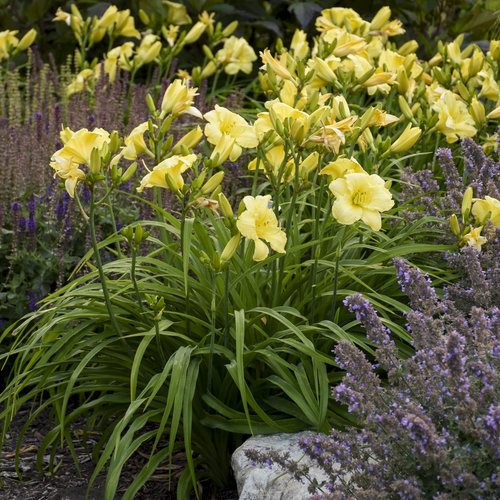 4. DaylilyRainbow Rhythm® ‘Going Bananas’ Zones: 3-9 One of the most beloved garden perennials, daylily produces trumpet-shaped flowers in a rainbow of colors that last just a day, hence the common name. Rainbow Rhythm® ‘Going Bananas’ is a reblooming variety with lightly scented, lemon-yellow flowers. The thick, grass-like foliage is moisture retentive, making plants less prone to igniting. |
 5. Dead NettlePink Chablis® Zones: 4-8 Dead nettle is a shade-loving ground cover with variegated foliage and tubular flower clusters that appear in spring. Pink Chablis® has pale-pink flowers and silvery foliage that brightens up shady woodland borders and containers. Dead nettle is known as a fireproof plant for its creeping growth habit and preference for moist, shady conditions that makes it less prone to fire. |
 6. HostaShadowland® ‘Empress Wu’ Zones: 3-9 A favorite shade-garden perennial, hosta is grown for the decorative leaves in a wide range of colors, patterns, and shapes. One of the largest hosta varieties, Shadowland® ‘Empress Wu’ produces oversized pleated green leaves. Hosta prefers damp, shady sites and has broad foliage and stems that retain water, making hosta plants less flammable. |
 7. Ice PlantKaleidoscope™ ‘Dancing Embers’ Zones: 5-10 Ice plant is a tough succulent with colorful, daisy-like flowers and is suitable for rock gardens and waterwise landscapes. Kaleidoscope™ ‘Dancing Embers’ has bright orange-red flowers with a cream center for eye-popping color in the landscape. Ground covers, such as ice plant, have a low growth habit that inhibits taller flames that would ignite a home, making it a good choice to plant near building structures. |
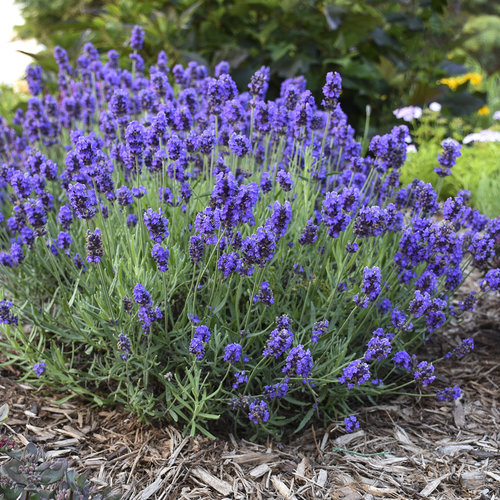 8. LavenderSweet Romance® Zones: 5-9 Lavender is one of the most popular herbs, with scented flowers and foliage that have a wide range of culinary and medicinal uses. Sweet Romance® is a dwarf variety with rich-purple flower spikes and a compact habit suitable for containers and small spaces. Though lavender plants contain oils, lavender is slow to ignite if kept moist. |
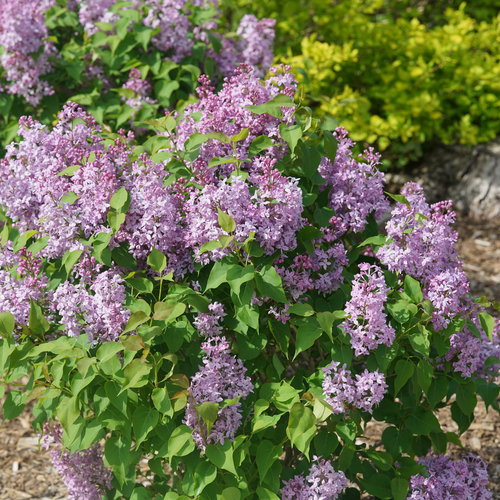 9. LilacScentara Pura® Zones: 2-8 Lilac shrub is an old-fashioned favorite, with scented flower clusters in spring. Scentara Pura® is one of the most intensely fragrant varieties, with soft-purple flowers and exceptional disease resistance. Plant fire-resistant shrubs, such as lilac, as a fire break around your property to help protect from intense heat. |
 10. MangaveArt & Sol™ ‘Thunderbird’ Zones: 9-11 Mangave is a tender, drought-tolerant succulent with spiky leaves and a symmetrical appearance that lends structure to rock gardens and waterwise landscapes. Art & Sol™ ‘Thunderbird’ is a petite variety with dark-green leaves dotted with red spots for eye-catching appeal. Mangave is less likely to be killed by fire due to the thick, fleshy leaves that retain moisture. |
 11. MockorangeIlluminati Sparks™ Zones: 4-7 This native shrub is grown for its intensely fragrant white flowers, attractive foliage, and elegant structure. Illuminati Sparks™ is a unique, variegated variety with yellow-speckled foliage and a smaller stature suitable for urban lots. |
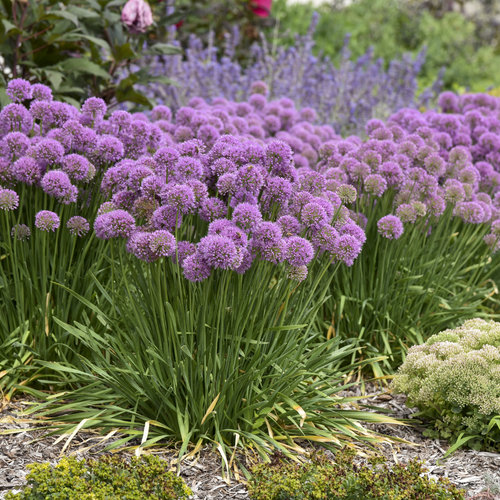 12. Ornamental Onion‘Serendipity’ Zones: 4-8 Also known as allium, this long-lived perennial produces strappy, grass-like foliage and rounded flower heads that lend structure to rock gardens and waterwise landscapes. ‘Serendipity’ has blue-green foliage that complements the rose-purple flowers. |
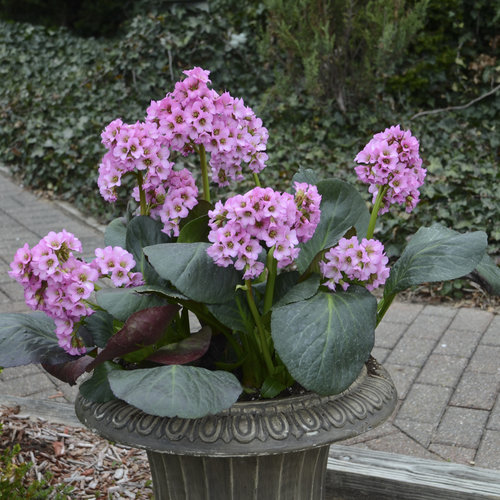 13. Pigsqueak‘Miss Piggy’ Zones: 4-8 Also known as bergenia, this hardy perennial has evergreen foliage and flowers that bloom from late winter to spring. The dark-green foliage of ‘Miss Piggy’ is complemented by bright-pink flower clusters. Plants have thick, fleshy leaves that are less flammable, with a short stature that makes pigsqueak less fire prone. |
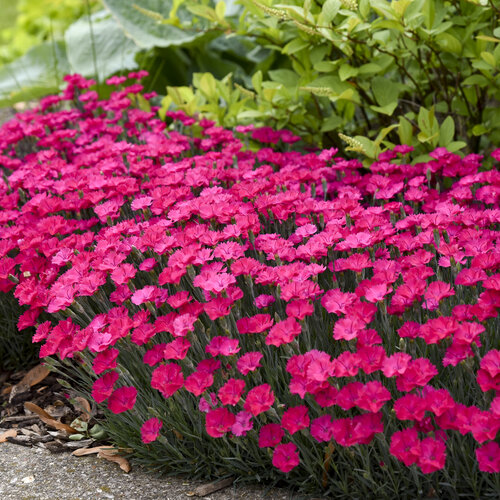 14. Pinks‘Paint the Town Magenta’ Zones: 4-9 Also known as pinks, dianthus is a drought-tolerant perennial with strappy foliage and carnation-like flowers in different colors and patterns. Clump-forming varieties are suited to rock gardens and waterwise landscapes. Dianthus has many low and creeping forms that are less prone to fire damage. |
 15. PurslaneMojave® Red Zones: 10-11 Purslane, also called portulaca, is a drought-tolerant succulent ground cover grown as an annual. It is useful for rock gardens, mass plantings, and xeriscapes. The vibrant crimson-red flowers of Mojave® Red bloom all summer long. With fleshy, moisture-retaining leaves and a low growth habit, purslane is a good choice for fire-resistant landscapes. |
 16. Red Hot PokerPyromania® ‘Orange Blaze’ Zones: 5-9 Also known as torch lily, this striking perennial has grass-like foliage and tall flower spikes that resemble red hot pokers, hence the common name. Use in waterwise strips or mixed borders. The bright-orange flowers of Pyromania® ‘Orange Blaze’ light up the summer landscape with sizzling color. Red hot poker is one of the best fire-safe plants to place near your home, with a high moisture content and fire-resistant blooms. |
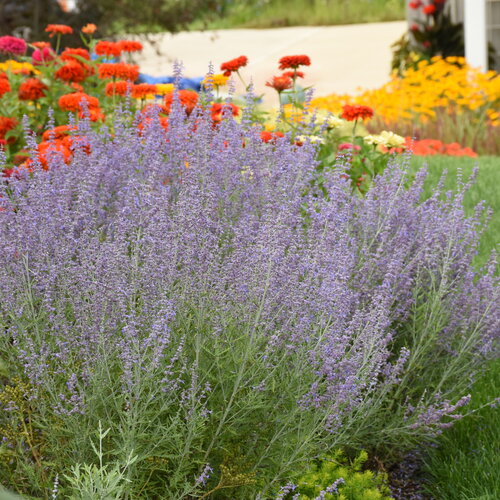 17. Russian Sage‘Denim ’n Lace’ Zones: 4-9 Russian sage is a carefree, shrubby perennial with long-lasting drifts of sky-blue flowers that appear in summer. ‘Denim ’n Lace’ has a compact, upright growth habit that is resistant to flopping. This heat- and drought-tolerant plant makes our list of fire-resistant plants, though plant placement should be away from homes or other structures due to oil content. |
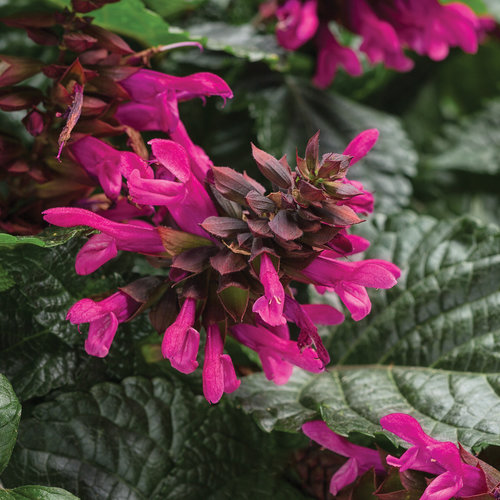 18. SalviaRockin’® Fuchsia Zones: 9-11 Salvia is a perennial or annual that thrives in heat and dry conditions. Plants come in a range of sizes and flower colors and are useful for mixed borders, rock gardens, and waterwise landscapes. Rockin’® Fuchsia has bright-magenta flowers with a black calyx for eye-popping contrast. |
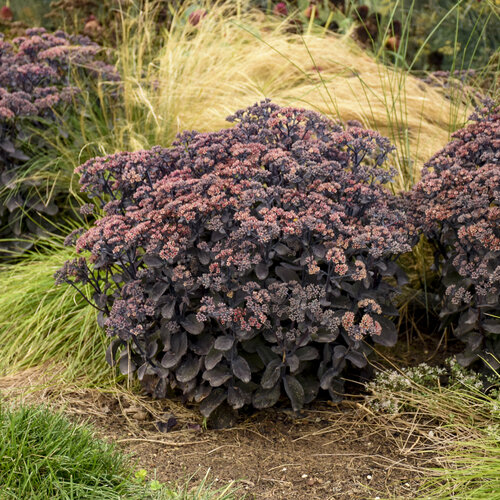 19. StonecropRock 'N Grow® ‘Back in Black’ Zones: 3-9 Stonecrop is a hardy perennial succulent with fleshy leaves and clusters of tiny, star-shaped flowers that add late-season color to the landscape. This carefree, heat- and drought-tolerant plant is commonly used in rock gardens and xeriscapes. Rock 'N Grow® ‘Back in Black’ produces deep-purple foliage and rose-pink flowers for a striking effect. Stonecrop is fire-resistant because of its drought tolerance and ability to store moisture in the thick, fleshy leaves. |
 20. Threadleaf CoreopsisDesigner Threads™ ‘Golden Needles’ Zones: 5-9 This rugged native wildflower is highly adaptable to most soils, and is suitable for meadow landscapes and pollinator gardens. Designer Threads™ ‘Golden Needles’ has golden-yellow flowers with a deep-maroon center for stunning contrast. Coreopsis is drought tolerant with a compact growth habit, making it more resistant to wildfires. |
 21. Toffee Twist SedgeGraceful Grasses® Toffee Twist Zones: 7-10 Sedge is a low-maintenance perennial with soft grass-like foliage that adds fine texture to beds, containers, and mass plantings. Graceful Grasses® Toffee Twist has brown foliage and an elegant, weeping habit that lends movement to the landscape. Sedge is drought tolerant and regenerates quickly after wildfires. |
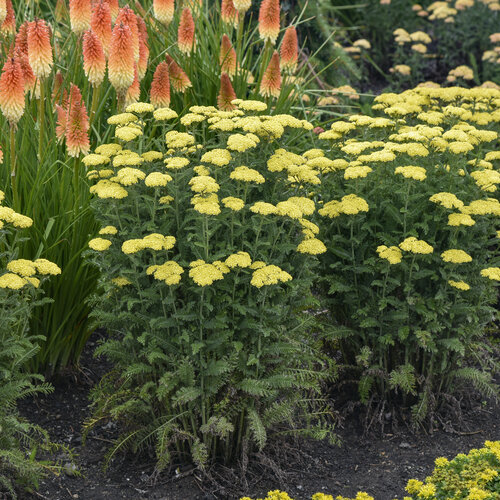 22. Yarrow‘Firefly Sunshine' Zones: 3-8 Yarrow is a tough native perennial with flat-topped flowers that support a range of pollinators. Plants are exceptionally drought tolerant and adaptable to poor soils. ‘Firefly Sunshine’ produces sunny-yellow flowers throughout summer, with a compact habit that is resistant to flopping. Yarrow is considered fire resistant for its low flammability and ability to quickly recover from wildfires. |
FAQs
What plants are most fire resistant?
Plants that are fire resistant have a high moisture content, green growth, open structure, watery sap, and little accumulated dead material. Plants can be damaged by fire, even if they are resistant, if fires burn hot enough. Most deciduous trees and shrubs, including oak trees and lilac shrubs, are fire resistant.
What flowers and plants are highly flammable?
Plants that contain volatile resins, gummy sap, or oils; have papery bark; or have dry, brown woody parts are more flammable. These include evergreen conifers and eucalyptus.
How to fireproof your yard?
Take these steps to protect your home and landscape from wildfires. Though this can help make your home safer, it won’t guarantee that your home and property will survive a wildfire.
- Create a defensible space by keeping plant material away from your home’s foundation.
- Keep garden areas cleared of dried leaves, underbrush, and other debris.
- Prune out dead woody growth from trees and shrubs, which can fuel fires.
- Place more flammable plants farther away from your home.
- Water areas around your home, which will slow a wildfire.
- Use less flammable landscape materials such as gravel, decorative rock, or a lawn as a buffer around your home.
- Keep flammable landscape materials such as bark dust away from your home’s foundation, and make sure it stays moist.
Sources
The following resources were consulted when selecting these plants:
Oregon State University Extension Service
Western Fire Chiefs Association
Idaho’s Fire Resistance of Plants Master Database
Buy Proven Winners plants:




